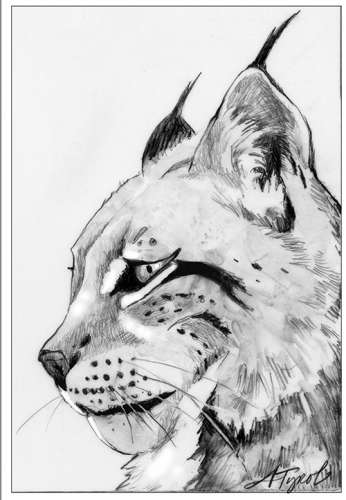
In the northern forest of New England, a big gray cat crouches silently in a dense thicket of fir along a snowshoe hare run. Its pointed ears, topped with long tufts of black hair, twitch as it listens intently. The cat’s face is framed by a fur ruff and its yellow-green eyes are alert for movement. Suddenly, the lynx pounces, killing its prey with one quick bite to the neck. As it pads away with the hare, the lynx’s broad furry paws act like snowshoes, supporting it in the deep snow. Its short tail is tipped with black.
The Canada lynx, once eliminated from most of New England by forest clearing and unsustainable hunting and trapping, is making a comeback. Though still listed as a federally threatened species, there is an expanding breeding population in northern and western Maine, smaller numbers of lynx in northern New Hampshire, and intermittently, cats have been found in Vermont.
The lynx is a creature of the boreal forest, that broad swath of conifers stretching the width of Canada. Northern New England is at the southern edge of its range. This snow cat specializes in hunting snowshoe hares, which make up over 75% of its winter diet. A lynx will consume one to two hares per day. Lynx are so closely tied to their favorite prey that their populations fluctuate with the peaks and lows in snowshoe hare populations. Lynx also eat squirrels, grouse, and other prey, as well as carrion, and their diet tends to vary more in summer, when eggs and fish may be part of the menu.
Lynx entered New England from Quebec beginning in the 1990s, and especially in the early 2000s, when lynx populations in the Gaspé Region were high. These dispersing lynx crossed the border into Maine, where they boosted a small remaining population and benefitted from extensive areas of regenerating spruce-fir forest, following the spruce budworm outbreak in the 1970s. This young forest supports high densities of snowshoe hares.
By 2006, state biologists estimated there were 750 to 1000 adult lynx in Maine. As this population grew, some lynx ventured southwest. By 2011, lynx sign was common in Pittsburg, New Hampshire and tracks have been found occasionally in the White Mountains. Jillian Kilborn, a wildlife biologist with New Hampshire Fish and Game, said the tracks in the mountains are probably from lynx wandering far afield during breeding season, but the White Mountain National Forest was once a stronghold for lynx. The state is working with the Northeast Climate Science Center at the University of Massachusetts Amherst to study whether its high-elevation spruce-fir forests have enough snowshoe hares to support lynx.
Vermont had its first record of lynx in 2003 and there have been 14 confirmed citizen sightings of the cats or their tracks since then. A lynx was photographed twice in southern Vermont last summer. Chris Bernier, wildlife biologist with the Vermont Fish and Wildlife Department, explained this was likely a yearling male searching for new territory; dispersing lynx have been known to travel up to 500 miles. He doesn’t believe the Green Mountains have enough snowshoe hares to support a breeding population, but the state and federal partners have recently installed remote cameras throughout the Greens, and in prime habitat in the Northeast Kingdom to monitor for lynx. Kilborn believes there is a small breeding population in the northern tip of New Hampshire. Bernier said there was evidence of reproduction for a few years, but except for the lynx sightings in southern Vermont last year, lynx have not been detected in the state since 2014.
Whether lynx survive in New England will depend on the continued existence of large blocks of forests connecting our states to lynx populations in Quebec and New Brunswick, explained Bernier. “Climate change and the changes in our winters we’ve been seeing recently are not a good thing for lynx,” warned Kilborn. Lynx are designed for deep, fluffy snow. Crusty snow resulting from thawing and refreezing puts them at a disadvantage when competing with coyotes, fishers, and bobcats for habitat and prey. Fishers are also predators of lynx, said Kilborn.
Do you think you’ve seen a lynx? Photos of the cats or their tracks in New Hampshire (which ideally should include several tracks and a ruler for scale) may be reported here. In Vermont, click here to report lynx sightings.
Be careful not to confuse a lynx with its more common cousin, the bobcat. Although individuals vary, this species has a spotted coat, shorter ear tufts, and a tail with black on top and white on the bottom. Lynx tracks are larger than those of a bobcat, and the toe pads appear smaller, as they are obscured by fur.

